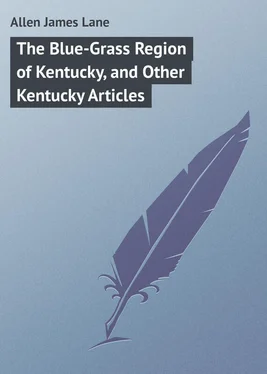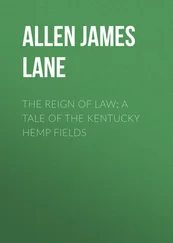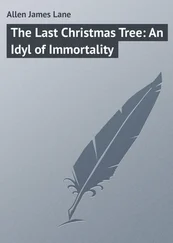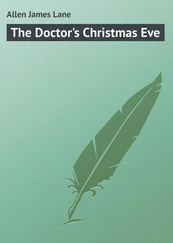James Allen - The Blue-Grass Region of Kentucky, and Other Kentucky Articles
Здесь есть возможность читать онлайн «James Allen - The Blue-Grass Region of Kentucky, and Other Kentucky Articles» — ознакомительный отрывок электронной книги совершенно бесплатно, а после прочтения отрывка купить полную версию. В некоторых случаях можно слушать аудио, скачать через торрент в формате fb2 и присутствует краткое содержание. Жанр: foreign_prose, Путешествия и география, на английском языке. Описание произведения, (предисловие) а так же отзывы посетителей доступны на портале библиотеки ЛибКат.
- Название:The Blue-Grass Region of Kentucky, and Other Kentucky Articles
- Автор:
- Жанр:
- Год:неизвестен
- ISBN:нет данных
- Рейтинг книги:3 / 5. Голосов: 1
-
Избранное:Добавить в избранное
- Отзывы:
-
Ваша оценка:
- 60
- 1
- 2
- 3
- 4
- 5
The Blue-Grass Region of Kentucky, and Other Kentucky Articles: краткое содержание, описание и аннотация
Предлагаем к чтению аннотацию, описание, краткое содержание или предисловие (зависит от того, что написал сам автор книги «The Blue-Grass Region of Kentucky, and Other Kentucky Articles»). Если вы не нашли необходимую информацию о книге — напишите в комментариях, мы постараемся отыскать её.
The Blue-Grass Region of Kentucky, and Other Kentucky Articles — читать онлайн ознакомительный отрывок
Ниже представлен текст книги, разбитый по страницам. Система сохранения места последней прочитанной страницы, позволяет с удобством читать онлайн бесплатно книгу «The Blue-Grass Region of Kentucky, and Other Kentucky Articles», без необходимости каждый раз заново искать на чём Вы остановились. Поставьте закладку, и сможете в любой момент перейти на страницу, на которой закончили чтение.
Интервал:
Закладка:
If the Kentuckian, like the Englishman, is fond of fencing himself off, like the Frenchman, he loves long, straight roads. You will not find elsewhere in America such highways as the Kentuckian has constructed over his country – broad, smooth, level, white, glistening turnpikes of macadamized limestone. It is a luxury to drive, and also an expense, as one will discover before one has passed through many toll-gates. One could travel more cheaply on the finest railway on the continent. What Richard Grant White thought it worth while to record as a rare and interesting sight – a man on an English highway breaking stones – is no uncommon sight here. All limestone for these hundreds of miles of road, having been quarried here, there, anywhere, and carted and strewn along the road-side, is broken by a hammer in the hand. By the highway the workman sits – usually an Irishman – pecking away at a long rugged pile as though he were good to live for a thousand years. Somehow, in patience, he always gets to the other end of his hard row.
One cannot sojourn long without coming to conceive an interest in this limestone, and loving to meet its rich warm hues on the landscape. It has made a deal of history: limestone blue-grass, limestone water, limestone roads, limestone fences, limestone bridges and arches, limestone engineering architecture, limestone water-mills, limestone spring-houses and homesteads – limestone Kentuckians! Outside of Scripture no people was ever so founded on a rock. It might be well to note, likewise, that the soil of this region is what scientists call sedentary – called so because it sits quietly on the rocks, not because the people sit quietly on it.
Undoubtedly the most picturesque monuments in the blue-grass country are old stone water-mills and old stone homesteads – landmarks each for separate trains of ideas that run to poetry and to history. The latter, built by pioneers or descendants of pioneers, nearly a hundred years ago, stand gray with years, but good for nameless years to come; great low chimneys, deep little windows, thick walls, mighty fireplaces; situated usually with keen discretion on an elevation near a spring, just as a Saxon forefather would have placed them centuries ago. Haply one will see the water of this spring issuing still from a recess in a hill-side, with an overhanging ledge of rock – the entrance to this cavern being walled across and closed with a gate, thus making, according to ancient fashion, a simple natural spring-house and dairy.
Something like a feeling of exasperation is apt to come over one in turning to the typical modern houses. Nowhere, certainly, in rural America, are there, within the same area, more substantial, comfortable homesteads. They are nothing if not spacious and healthful, frame or brick, two stories, shingle roofs. But they lack characteristic physiognomy; they have no harmony with the landscape, nor with each other, nor often with themselves. They are not beautiful when new, and can never be beautiful when old; for the beauty of newness and the beauty of oldness alike depend on beauty of form and color, which here is lacking. One longs for the sight of a rural Gothic cottage, which would harmonize so well with the order of the scenery, or for a light, elegant villa that should overlook these light and elegant undulations of a beautiful and varied landscape. It must be understood that there are notable exceptions to these statements even in the outlying districts of the blue-grass country, and that they do not apply to the environs of the towns, nor to the towns themselves.
Nowhere does one see masses of merely beautiful things in the country. The slumbering art of interior decoration is usually spent upon the parlor. The grounds around the houses are not kept in the best order. The typical rural Kentucky housewife does not seem to have any compelling, controlling sense of the beautiful. She invariably concedes something to beauty, but not enough. You will find a show of flowers at the poorest houses, though but geranium slips in miscellaneous tins and pottery. But you do not generally see around more prosperous homes any such parterres or beds as there is money to spend on, and time to tend, and grounds to justify.
A like spirit is shown by the ordinary blue-grass farmer. His management strikes you as not the pink of tidiness, not the model of systematic thrift. Exceptions exist – many exceptions – but the rule holds good. One cannot travel here in summer or autumn without observing that weeds flourish where they harm and create ugliness; fences go unrepaired; gates may be found swinging on one hinge. He misuses his long-cultivated fields; he cuts down his scant, precious trees. His energy is not tireless, his watchfulness not sleepless. Why should they be? Human life here is not massed and swarming. The occupation of the soil is not close and niggard. The landscape is not even compact, much less crowded. There is room for more, plenty for more to eat. No man here, like the ancient Roman prætor, ever decided how often one might, without trespass, gather the acorns that fall from his neighbors' trees. No woman ever went through a blue-grass harvest field gleaning. Ruth's vocation is unknown. By nature the Kentuckian is no rigid economist. By birth, education, tradition, and inherited tendencies he is not a country clout, but a rural gentleman. His ideal of life is neither vast wealth nor personal distinction, but solid comfort in material conditions, and the material conditions are easy: fertility of soil, annual excess of production over consumption, comparative thinness of population. So he does not brace himself for the tense struggle of life as it goes on in centres of fierce territorial shoulder-pushing. He can afford to indulge his slackness of endeavor. He is neither an alert aggressive agriculturist, nor a landscape gardener, nor a purveyor of commodities to the green-grocer. If the world wants vegetables, let it raise them. He declines to work himself to death for other people, though they pay him for it. His wife is a lady, not a domestic laborer; and it is her privilege, in household affairs, placidly to surround herself with an abundance which the lifelong female economists of the North would regard with conscientious indignation.
In truth, there is much evidence to show that this park-like country, intersected by many beautiful railroads, turnpikes, and shaded picturesque lanes, will become less and less an agricultural district, more and more a region of unequalled pasturage, and hence more park-like still. One great interest abides here, of course – the manufacture of Bourbon whiskey. Another interest has only within the last few years been developed – the cultivation of tobacco, for which it was formerly thought that the blue-grass soils were not adapted. But as years go by, the stock interests invite more capital, demand more attention, give more pleasure – in a word, strike the full chord of modern interest by furnishing an unparalleled means of speculative profit.
Forty years ago the most distinguished citizens of the State were engaged in writing essays and prize papers on scientific agriculture. A regular trotting track was not to be found in the whole country. Nothing was thought of the breeding and training of horses with reference to development of greater speed. Pacing horses were fashionable; and two great rivals in this gait having been brought together for a trial of speed, in lieu of a track, paced a mighty race over a river-bottom flat. We have changed all that. The gentlemen no longer write their essays. Beef won the spurs of knighthood. In Kentucky the horse has already been styled the first citizen. The great agricultural fairs of the State have modified their exhibits with reference to him alone, and fifteen or twenty thousand people give afternoon after afternoon to the contemplation of his beauty and his speed. His one rival is the thoroughbred, who goes on running faster and faster. One of the brief code of nine laws for the government of the young Kentucky commonwealth that were passed in the first legislative assembly ever held west of the Alleghanies dealt with the preservation of the breed of horses. Nothing was said of education. The Kentuckian loves the memory of Thomas Jefferson, not forgetting that he once ran racehorses. These great interests, not overlooking the cattle interest, the manufacture of whiskey, and the raising of tobacco, will no doubt constitute the future determining factors in the history of this country. It should not be forgotten, however, that the Northern and Eastern palate becomes kindly disposed at the bare mention of the many thousands of turkeys that annually fatten on these plains.
Читать дальшеИнтервал:
Закладка:
Похожие книги на «The Blue-Grass Region of Kentucky, and Other Kentucky Articles»
Представляем Вашему вниманию похожие книги на «The Blue-Grass Region of Kentucky, and Other Kentucky Articles» списком для выбора. Мы отобрали схожую по названию и смыслу литературу в надежде предоставить читателям больше вариантов отыскать новые, интересные, ещё непрочитанные произведения.
Обсуждение, отзывы о книге «The Blue-Grass Region of Kentucky, and Other Kentucky Articles» и просто собственные мнения читателей. Оставьте ваши комментарии, напишите, что Вы думаете о произведении, его смысле или главных героях. Укажите что конкретно понравилось, а что нет, и почему Вы так считаете.











